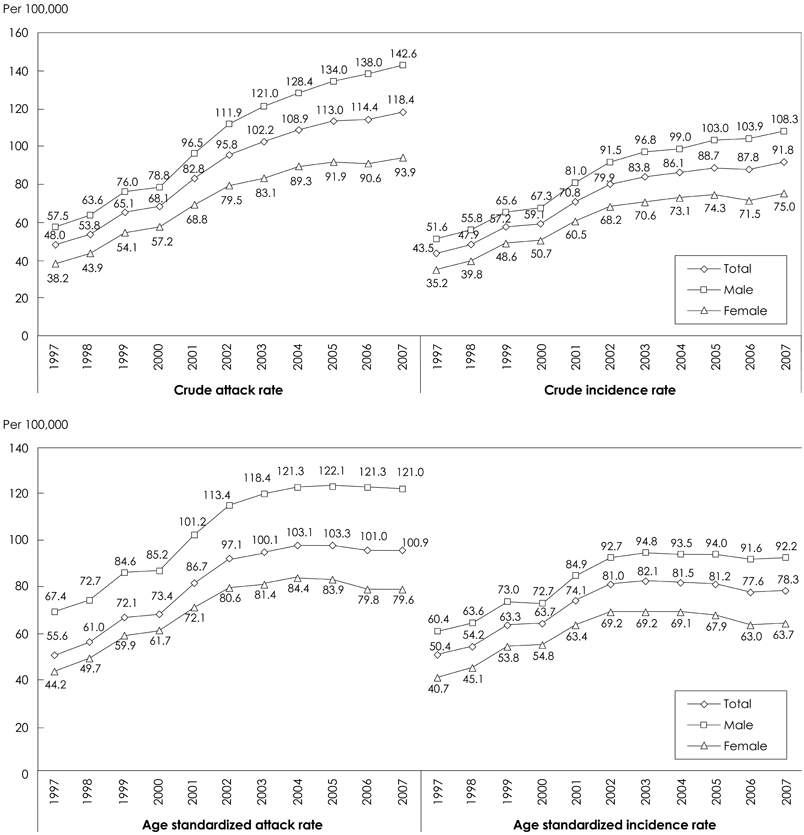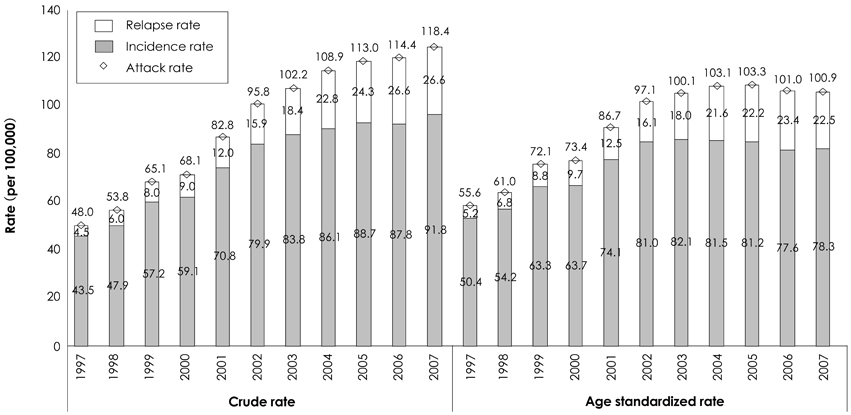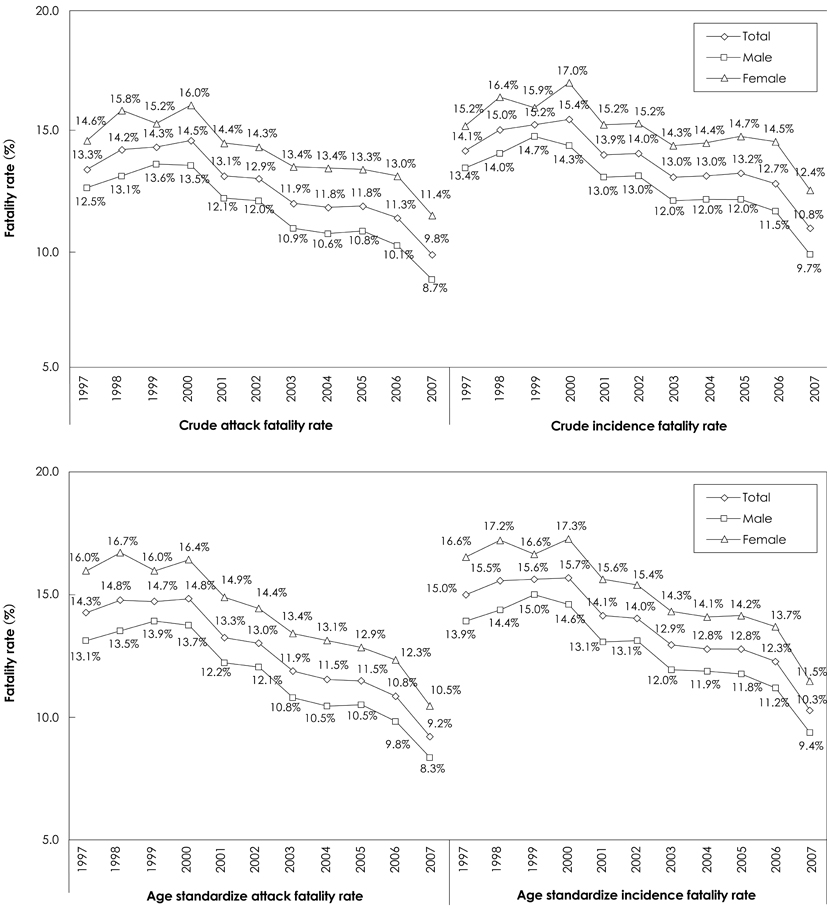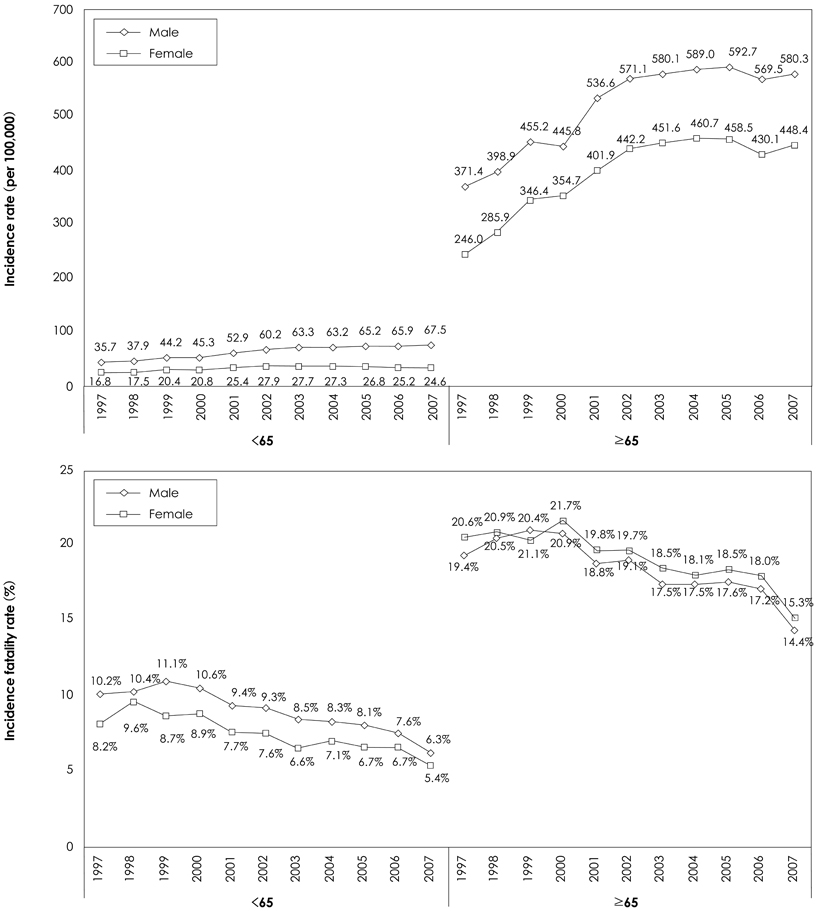Long-Term Trend in the Incidence of Acute Myocardial Infarction in Korea: 1997-2007
- Affiliations
-
- 1Health Insurance Review & Assessment Policy Institute, Health Insurance Review & Assessment Service, Seoul, Korea.
- 2Comprehensive Review System Planning Department, Health Insurance Review & Assessment Service, Seoul, Korea.
- 3Department of Social and Preventive Medicine, Hallym University College of Medicine, Chuncheon, Korea. dr_hongjs@hanmail.net
- KMID: 2225649
- DOI: http://doi.org/10.4070/kcj.2009.39.11.467
Abstract
- BACKGROUND AND OBJECTIVES
Information about disease incidence is indispensable for the active prevention and control of acute myocardial infarction (AMI). The purpose of this study was to provide basic information for the establishment of policy related to AMI by examining the long-term trends in incidence of AMI.
SUBJECTS AND METHODS
This study identified the trend in disease incidence during between 1997 and 2007 using the Korean National Health Insurance Database that includes AMI {the 10th International Classification of Disease (ICD-10) code: I21, I22, I23, I250, I251} as a primary or secondary disease.
RESULTS
The attack and incidence rates for AMI in 2007 were 118.4 and 91.8 per 100,000 persons, respectively, and the rates more than doubled for the 11 years. Both rates were higher among males than females and increased more in the older age groups. Incidence cases accounted for most of the total attack cases every year; however, in recent years the proportion of relapse cases was on the rise. The case fatality rate was highest (14.5%) in 2000, and declined rapidly to 9.8% in 2007. The case fatality rate was higher among females than males and the older age groups; in particular, female patients > or=65 years of age had the highest fatality rate.
CONCLUSION
This study showed that AMI has been on the rise in Korea for 11 years. Therefore, the establishment of policy for intensive control of the incidence of AMI is necessary by building a continuous monitoring and surveillance system.
Keyword
MeSH Terms
Figure
Cited by 6 articles
-
Use of Combined Oral Contraceptives in Perimenopausal Women
Moon Kyoung Cho
Chonnam Med J. 2018;54(3):153-158. doi: 10.4068/cmj.2018.54.3.153.Epidemiology of dyslipidemia in Korea
Hyeon Chang Kim
J Korean Med Assoc. 2016;59(5):352-357. doi: 10.5124/jkma.2016.59.5.352.Diagnosis and management of acute coronary syndrome
Doo Soo Jeon
J Korean Med Assoc. 2017;60(7):568-576. doi: 10.5124/jkma.2017.60.7.568.2018 Guidelines for the Management of Dyslipidemia in Korea
Eun-Jung Rhee, Hyeon Chang Kim, Jae Hyeon Kim, Eun Young Lee, Byung Jin Kim, Eun Mi Kim, YoonJu Song, Jeong Hyun Lim, Hae Jin Kim, Seonghoon Choi, Min Kyong Moon, Jin Oh Na, Kwang-Yeol Park, Mi Sun Oh, Sang Youb Han, Junghyun Noh, Kyung Hee Yi, Sang-Hak Lee, Soon-Cheol Hong, In-Kyung Jeong,
J Lipid Atheroscler. 2019;8(2):78-131. doi: 10.12997/jla.2019.8.2.78.Korea Heart Disease Fact Sheet 2020: Analysis of Nationwide Data
Hyeok-Hee Lee, So Mi Jemma Cho, Hokyou Lee, Jongmin Baek, Jang-Ho Bae, Wook-Jin Chung, Hyeon Chang Kim
Korean Circ J. 2021;51(6):495-503. doi: 10.4070/kcj.2021.0097.Management of Hypertension in Diabetic Patients
Sang Yong Kim
J Korean Diabetes. 2016;17(2):88-95. doi: 10.4093/jkd.2016.17.2.88.
Reference
-
1. Hyun DW, Kim KS, Synn YC, et al. Clinical characteristic of acute infarction died during hospitalization. Korean Circ J. 1998. 28:1518–1526.2. Tunstall-Pedoe H, Kuulasmaa K, Amouyel P, Arveiler D, Rajakangas AM, Pajak A. Myocardial infarction and coronary deaths in the World Health Organization MONICA Project: registration procedures, event rates, and case-fatality rates in 38 populations from 21 countries in four continents. Circulation. 1994. 90:583–612.3. Fortmann SP, Haskell WL, Williams PT, Varady AN, Hulley SB, Farquhar JW. Community surveillance of cardiovascular diseases in the Stanford Five-City Project: methods and initial experience. Am J Epidemiol. 1986. 123:656–669.4. Alpert JS, Thygesen K, Antman E, Bassand JP. Myocardial infarction redefined: a consensus document of The Joint European Society of Cardiology/American College of Cardiology Committee for the redefinition of myocardial infarction. J Am Coll Cardiol. 2000. 36:959–969.5. Kim JY. Construction of National Surveillance System for Cardiovascular and Cerebrovascular Disease. 2006. Health Insurance Review & Assessment Service.6. Kim JY. Burden of disease by socioeconomic status. Health Welfare Policy Forum. 2004. 92:40–52.7. Korean Statistical Information Service. Korea National Statistical Office. Available from: http://www.kosis.kr.8. Abildstrom SZ, Rasmussen S, Rosén M, Madsen M. Trends in incidence and case fatality rates of acute myocardial infarction in Denmark and Sweden. Heart. 2003. 89:507–511.9. Park SH. Risk stratification of acute coronary syndrome. Korean Circ J. 2002. 32:739–755.10. Lundblad D, Holmgren L, Jansson JH, Näslund U, Eliasson M. Gender differences in trends of acute myocardial infarction events: the Northern Sweden MONICA study 1985-2004. BMC Cardiovasc Disord. 2008. 8:17.11. Chun BY, Kim KB, Kim KS, et al. The incidence rate of coronary heart disease in city area. Korean J Prev Med. 1998. 31:395–403.12. Hong JS, Kang HC, Yi SW, et al. Age at menopause and cause-specific mortality in South Korean women: Kangwha Cohort Study. Maturitas. 2007. 56:411–419.13. Haffner SM, Katz MS, Srern MP, Dunn JF. Association of decreased sex hormone binding globulin and cardiovascular risk factors. Arteriosclerosis. 1989. 9:136–143.14. Haffner SM, Dunn JF, Katz MS. Relationship of sex hormone-binding globulin to lipid, lipoprotein, glucose, and insulin concentrations in postmenopausal women. Metabolism. 1992. 41:278–284.15. Haffner SM, Newcomb PA, Marcus PM, Klein BE, Klein R. Relation of sex hormones and dehydroepiandrosterone sulfate (DHEA-SO4) to cardiovascular risk factors in postmenopausal women. Am J Epidemiol. 1995. 142:925–934.16. Wellenius GA, Mittleman MA. Disparities in myocardial infarction case fatality rates among the elderly: the 20-year Medicare experience. Am Heart J. 2008. 156:483–490.17. Park KS, Yoon SH, Lee BH, Lee CK. Prognostic studies on acute myocardial infarction. Korean Circ J. 1982. 12:49–58.18. Lee DH, Yun WJ, Park YH, Lee CW, Lee KY. Clinical study on acute myocardial infarction. Korean J Med. 1984. 27:1082–1091.19. Kwon HC, Lyu OY, Park SW, et al. Long term survival rate and prognostic factors of acute myocardial infarction. Korean Circ J. 1990. 20:687–696.20. Rosén M, Alfredsson L, Hammar N, Kahan T, Spetz CL, Ysberg AS. Attack rate, mortality and case fatality for acute myocardial infarction in Sweden during 1987-95. J Intern Med. 2000. 248:159–164.21. Liew R, Sulfi S, Ranjadayalan K, Cooper J, Timmis AD. Declining case fatality rates for acute myocardial infarction in South Asian and white patients in the past 15 years. Heart. 2006. 92:1030–1034.22. Kang JC. Acute myocardial infarction in Korea. Korean Circ J. 1993. 23:495–497.23. Manolio T, Furberg CD. Age as a predictor of outcome: what role does it play? Am J Med. 1992. 92:1–6.24. Paul SD, O'Gara PT, Mahjoub ZA, et al. Geriatric patients with acute myocardial infarction: cardiac risk factors profiles, presentation, thrombolysis, coronary interventions, and prognosis. Am Heart J. 1996. 131:710–715.25. Maynard C, Litwin PE, Martin JS, Weaver WD. Gender differences in the treatment and outcome of acute myocardial infarction. Arch Intern Med. 1992. 152:972–976.26. Karlson BW, Herlitz J, Hartford M. Prognosis in myocardial infarction in relation to gender. Am Heart J. 1994. 128:477–483.27. Fiebach NH, Viscoli CM, Horwitz RI. Differences between women and men in survival after myocardial infarction: biology and methodology. JAMA. 1990. 263:1092–1096.28. Grimm RH Jr, Tillinghast S, Daniels K, et al. Unrecognized myocardial infarction: experience in the Multiple Risk Factor Intervention Trial (MRFIT). Circulation. 1987. 75:II6–II8.29. Tunstall-Pedoe H. Diagnosis, measurement and surveillance of coronary events. Int J Epidemiol. 1989. 18:3 Suppl 1. S169–S173.30. Ash AS, Posner MA, Speckman J, Franco S, Yacht AC, Bramwell L. Using claims data to examine mortality trends following hospitalization for heart attack in Medicare. Health Serv Res. 2003. 38:1253–1262.
- Full Text Links
- Actions
-
Cited
- CITED
-
- Close
- Share
- Similar articles
-
- Can time delay be shortened in the treatment of acute myocardial infarction?: Experience from Korea acute myocardial infarction registry
- Invasive Treatment of Acute Myocardial Infarction: What is the Optimal Therapy for Acute Myocardial Infarction?
- Intracoronary Stenting in Acute Myocardial Infarction
- Incidence of Left Ventricular Thrombus after Acute Myocardial Infarction
- Correlation between Abnormal Q Wave in Leads I or aVL and First Diagonal Branch Stenosis in Patients with Acute Myocardial Infarction





